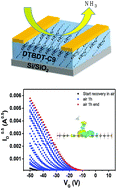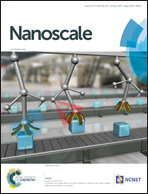An ammonia detecting mechanism for organic transistors as revealed by their recovery processes†
Abstract
Organic thin film transistor (OTFT) based gas sensors have demonstrated promising applications, owing to their advantages of high selectivity and room temperature operation, accompanied by their low cost, large scale manufacture, and flexibility. However, the understanding of the sensing mechanism is far from clear. Herein, we reveal the sensing mechanism of an organic transistor sensor for ammonia (NH3) detection through studying the recovery behavior in various atmospheres. Inspired by the significant difference in the recovery of the transistor sensor in N2 and in air, we deduced that the operation mechanism should not only involve the NH3–film interaction. Among a series of recovery processes, only upon exposure to wet air can the sensors completely recover in a certain time. Such a phenomenon, coupled with the transistor’s performance evolution under vacuum, directly evidenced the existence of a pre-doping effect in the transistor by water (H2O) in ambient air. As a result, the response to the NH3 analyte is actually a de-doping process via reaction with the H2O. The full recovery in wet air is attributable to re-doping by H2O. Density functional theory (DFT) calculations were employed to assist the understanding of such a sensing mechanism. This study could help in the understanding of the sensing processes in many organic semiconductor based sensors.

- This article is part of the themed collection: Celebrating Excellence in Research: Women of Materials Science


 Please wait while we load your content...
Please wait while we load your content...